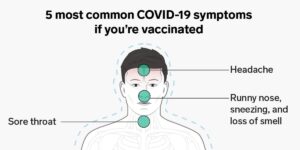The Most Common COVID Symptoms After Vaccination

Even as the rate of inoculation rises and more individuals throughout the world get inoculated, we are hearing more and more about incidents of breakthrough infections. Although the overall number of instances is still significantly smaller than the number of unvaccinated persons who develop COVID-19, hearing about breakthrough cases, or those who contract COVID-19 after infection, might be perplexing.
Though clinical evidence suggests that vaccines can effectively reduce overall illness risk, from seriousness to survival, being immunized can also cause people to experience somewhat different symptoms than those who have not been vaccinated. However there is no specific reason for this, or no other effect other than the Delta version to blame for the rise in post-vaccination COVID instances, professionals do suggest that differentiating among infectious disease symptomatology can help a person establish risks and determine whether they are suffering from COVID or something else.
Because only a small number of patients suffer serious sickness after immunization, these symptoms may signal a breakthrough infection:
Sore Throat
A throat infection (pharyngitis) or soreness of the throat is a common indicator that you’ve been infected with a virus. When the SARS-COV-2 virus attacks the body, it’s also one of the most common symptoms. A viral infection can cause discomfort in the throat, which can cause pain or a scratchy feeling. Some people even notice a faint burning or itching sensation that gets worse when they consume food or liquids. A sore throat might be made worse by a hoarse or muffled voice, the development of white patches (only clinically observed), or swelling.
Headache
Whenever unvaccinated, as well as vaccinated individuals, develop COVID-19, headache, a frequent form of myalgia, can be another prevalent symptom. Even while the myalgia and bodily pain associated with a COVID-19 infection can be intense, headache is frequently one of the first indicators of disease and occurs when the upper respiratory tract is inflamed. However, the study also found that people who are just partially vaccinated can get a fever from this virus (more likely than someone who is fully vaccinated).
Runny Nose
A bad cold is yet another sign that can alter depending on whether or not you have been inoculated against COVID. While it isn’t a characteristic symptom of the virus, several experts believe that as the virus evolves, few people may develop a runny nose or obstruction if they test positive. This can seem like flu and last for a long time.
Sneezing
Sneezing is a characteristic of those who have been fully vaccinated but have tested positive for the disease. While researchers continue to investigate what causes a shift in symptom patterns, episodes of sneezing can be mistaken for a cold, necessitating greater awareness of the signs and symptoms of breakthrough infection. Some anecdotal information suggests that sneeze is a common vaccine side effect for persons who have previously received COVID-19.
Persistent Coughing
Prolonged coughing is a warning that should not be overlooked among those who are just partially vaccinated, meaning they are at a higher risk of contracting the sickness and having poorer outcomes. COVID variations can induce symptoms that are faster, moderate, or severe, and chronic coughing can be a marker of respiratory tract inflammation. A prolonged, chronic cough can also be bothersome and take longer to resolve.





